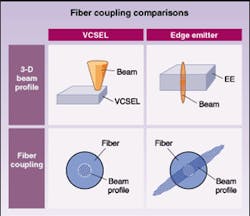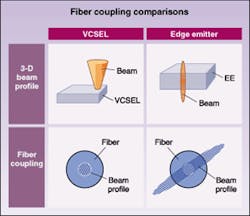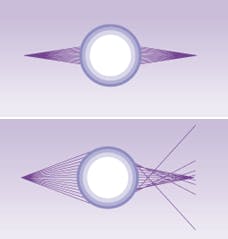Long-wavelength VCSELs optimize fiber coupling
Tess Abidi
The migration of vertical-cavity surface-emitting laser technology to long-haul applications is laying the foundation for optimizing fiber coupling.As the global optical networking infrastructure evolves into the de facto foundation for the convergence of datacom and telecom applications, the need for highly reliable and cost-effective optical interfaces has become a factor critical to future success. Driven by the constant inflow of millions of new users, demands of bandwidth-hungry multimedia applications, and the need to effectively handle a variety of latency-sensitive traffic, the bar is constantly being raised for delivering high-speed optical performance from the network core all the way out through the edge.
At the network edge, the rapidly escalating migration to broadband is driving the need for metro-area service providers to terminate millions of new broadband lines and handle escalating traffic levels. Toward the core of the network, the emergence of high-speed fiberoptic links such as OC-48 (2.5 Gbit/s) and OC-192 (10 Gbit/s), along with dense wavelength-division multiplexing (DWDM), are dramatically increasing the number of links available and per-link transmission speeds.
The coupling efficiency between the optical interface and the fiber has come to represent a critical nexus upon which the performance of the network is directly dependent. With conventional laser-diode technologies used for longer-haul optical links, managing the fiber-coupling interface frequently requires the addition of complex and costly optomechanical mechanisms and lenses between the diode and the fiber. The migration of vertical-cavity surface-emitting laser (VCSEL) technology from proven short-haul applications to long-haul applications is now laying the foundation for new opportunities to optimize fiber couplingminimizing cost and complexity.
Edge-emitting laser diodes vs. VCSELs
Traditional edge-emitting devices, such as Fabry Perot or distributed feedback (DFB) lasers, launch light from an aperture on the edge of the device. To create the horizontal lasing cavity within an edge-emitter, these devices must be put through a multistep crystal cleaving process. This process must be completed on all individual devices or rows of devices before they can be tested as lasers.
In contrast, a VCSEL is formed through vertical stacking of high-reflectivity mirrors that are grown in a single process. As many as 30 individual semiconductor layers may be stacked within a VCSEL structure, only 10 µm thick, which emits light vertically from the surface of the device through a circular aperture 5 to 25 µm in diameter. VCSELs can be fully tested while still in the wafer stage.
Over the past few years, proven 850-nm VCSEL technology deployed within short-haul links has delivered consistent light-launch characteristics and robust operation. For longer metropolitan area network (MAN) and wide area network (WAN) links, however, choices have been limited to relatively expensive edge-emitting lasers. The recent development of long-wavelength (1310-nm) surface-emitting devices has now opened the door for extending the advantages of VCSEL technology across the entire spectrum of long-haul and short-haul links.
Beam profile issues
Edge-emitting lasers have rectangular cavities that produce highly asymmetric elliptical beams with significant divergence. With a divergence angle of approximately 50° to 60° in the plane perpendicular to the junction and 10° to 12° in the parallel plane, edge-emitters make it difficult to focus the beam into a circular fiber with commercial-grade optics.
In addition to being elliptical, edge-emitters have a physical gap between the locations of the two facetsresulting in a large astigmatism factor. Not only does astigmatism affect spot size, it also has a dramatic effect on the spot geometry within the depth of focus where the beam rapidly changes shape from a horizontally elliptical image to a vertically elliptical ellipse.
Vertical cavity lasers can be designed to emit light from a uniformly circular aperture on the surface of the device. This results in a beam profile that is symmetrical, less divergent, and able to be efficiently focused into the fiber with relatively simple optics, or even without the use of external optics. Typically, VCSELs begin with 85% or greater coupling efficiency. In contrast, edge-emitting lasers have a raw coupling efficiency of about 30% to 50%, which requires complicated optics to achieve more acceptable results (see Fig. 1).
Optical subassembly issues
One of the most critical issues in fiber coupling involves achievement of an optimal beam profile. The goal is to have a symmetrical and tightly constrained beam that can be focused into the fiber using relatively simple and low-cost optics.
Single-mode fibers have a core diameter of 8 to 10 µm and a numerical aperture of about 0.1 to 0.13. The light launching optics must be diffraction limited to achieve high coupling efficiency. The ellipticity, high divergence, and astigmatism in edge-emitters make it challenging to couple light into single mode. VCSELs, on the other hand, can be tuned to match the mode field diameter of single-mode fibers, to yield high coupling efficiency with less expensive lenses.
The VCSEL launch provides improved performance over multimode fibers, which have larger core diameters than single-mode fibers. It also has a controlled launch power distribution and yields a higher system bandwidth for the multimode fiber. The multimode fiber has several mode groups, which travel at different speeds through the fiber. This differential-mode delay (DMD) affects the bandwidth and the information carrying capacity of the fiber. To reduce DMD effects and increase bandwidth, it is critical to restrict the beam to a smaller mode group.
Many fiberoptic subassemblies use a ball lens, which is generally insensitive to tilt and makes for easier alignment. The optical output beam from a ball lens is highly dependant upon the optical input beam to the lens (see Fig. 2).
A laser with high divergence presents difficulties in obtaining a sharp focus through the lens since the on-axis rays focus farther away and the off-axis rays focus closer to the lens. The result is a spreading out of the spot size, known as spherical aberration.
When a laser source such as a VCSEL is focused by a ball lens at the face of the fiber, its numerical aperture is well within the acceptance angle of the fiber and the image is well constrained in size. Such an optical subassembly provides high coupling efficiency.
A highly divergent laser source, such as an edge-emitting laser diode, when focused by the same lens, will yield a more diffused spot size (aberration proportional to divergence) that will not couple well into the fiber. Apart from the spot size, if the higher divergent rays are outside the acceptance angle of the fiber they will not traverse through the fiber. This will also affect coupling efficiency.
The optical beam, when presented to the fiber, must match with the fiber's inherent mode-field diameter in order to achieve high coupling efficiency and support required propagation distances. To achieve this, edge-emitting laser-based optical sub-assemblies require complex and expensive optics such as anamorphic prisms, cylindrical lenses for beam shaping, and additional aspheric or GRIN optics for beam focusing.
With these complex multilens structures, the need for precision alignment during manufacturing and the ability to ensure ongoing alignment stability also become critical factors for success. These designs also significantly increase the overall length of the optical cavity, which creates difficult tradeoffs between improving coupling efficiency and controlling the cost and size of the assembly. Because of the need to keep the optics as small as possible, only a portion of the highly divergent beam in the perpendicular axis can be effectively captured. Since the perpendicular beam is being diffracted at the edges of the focusing lens, it superimposes on the primary imaging beam and causes a broadening of the image.
In contrast to the complexity of edge-emitters, the optical subassembly requirements for VCSEL devices are simple and straightforward. The inherently circular and low divergent beam characteristics allow for sharp focus, superior near diffraction limited performance, and a consistently spherical spot size. As a result, VCSELs can produce a significantly higher directly coupled power that can be further improved by using a relatively inexpensive off-the-shelf ball lens. Because VCSELs' beam characteristics can be tuned to match the fibers' requirements, additional lenses can be eliminated for beam shaping or alignment adjustments.
A relatively new generation of edge-emitting devices, generally known as "spot-size converted" (SSC) lasers, has attempted to address the beam characteristic deficiencies in standard edge-emitters. The use of SSC devices helps produce a more consistent circular beam directly from the edge-emitting device, which reduces the need for complex external optics. However, because SSCs require an additional dry-etch process and/or epitaxial growth step during semiconductor fabrication, they are significantly more expensive than standard edge-emitters and generally experience lower production yields.
An additional issue with DFB laser diodes is their susceptibility to back-reflections of light from the fiber resulting in increased optical noise on the signal. As a result, optical isolators are often needed to prevent reflected light from imaging back into the laser. In contrast, VCSELs can be designed to be less susceptible to these reflections. Simple modifications in the OSA design, such as beam defocus or intentional tilt, practically eliminate back reflection noise.
Other architectural issues
Driven by the proliferation of DWDM links and the convergence of data and voice traffic over shared optical networks, new-generation optical switching architectures must be able to tightly pack many optical transceivers within ever-shrinking form factors. In such dense fiber arrays, however, the larger optics, higher power requirements, and inferior beam characteristics of traditional edge-emitting laser diodes can pose extreme design challenges.
In particular, the high beam divergence of laser diodes can lead to optical crosstalk issues within dense arrays that make it difficult to maintain sufficient signal integrity and to prevent the risk of light spillover into receiver channels. Also, because of the complex external optics required with edge-emitting laser diodes, in a tightly packed array there exists a significant risk of off-axis rays being picked up by adjacent lenses and coupled into the wrong fibers. In contrast, the tight spherical beam characteristics of VCSELs make them suitable for implementing dense fiber arrays with a minimum of optical crosstalk, while at the same time their low-power usage helps reduce the electronics complexity required to drive such next-generation VCSEL based arrays.
The introduction of long-wavelength VCSELs with superior light-coupling characteristics, low divergence, and lower power requirements has opened the door for more economical deployment of 1310-nm fiber links. It is now making possible a host of new higher-density architectural alternatives to support next-generation communications applications. As optical networking continues to migrate out from the WAN core into metropolitan area networks and edge aggregation applications, the need to efficiently terminate and optically switch huge numbers of fiber links has become a key architectural requirement. VCSEL devices now operating to 1310-nm specifications provide the ideal solution to meet these technical and economic challenges.
TESS ABIDI is a senior optical engineer at Cielo Communications, 325 Interlaken Parkway, Building A, Broomfield, CO 80021; e-mail: [email protected].


